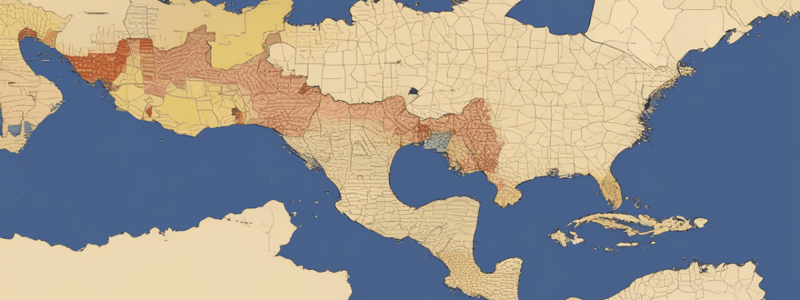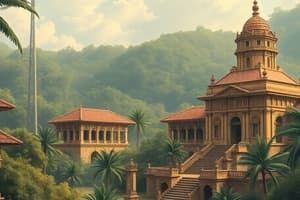Podcast
Questions and Answers
What is the primary focal point of the Costa Rica-Nicaragua conflict?
What is the primary focal point of the Costa Rica-Nicaragua conflict?
the shared border between the two Central American nations
How do the geographical landscapes of Costa Rica and Nicaragua differ?
How do the geographical landscapes of Costa Rica and Nicaragua differ?
Costa Rica is known for its stability and environmental richness, while Nicaragua has a larger landmass and a history of political turbulence
Who sparked the Costa Rica-Nicaragua conflict in 1918?
Who sparked the Costa Rica-Nicaragua conflict in 1918?
Costa Rican military dictator General Federico Tinoco
What was the outcome of General José Figueres' seizure of power in Costa Rica in 1948?
What was the outcome of General José Figueres' seizure of power in Costa Rica in 1948?
What event in 1955 reignited the conflict?
What event in 1955 reignited the conflict?
What was the role of the United States in the Costa Rica-Nicaragua conflict?
What was the role of the United States in the Costa Rica-Nicaragua conflict?
What was the outcome of the Organization of American States' (OAS) mediation of the conflict?
What was the outcome of the Organization of American States' (OAS) mediation of the conflict?
What was the impact of the conflict on Central America?
What was the impact of the conflict on Central America?
What was the outcome of Tinoco's attempt to solidify his regime through military action?
What was the outcome of Tinoco's attempt to solidify his regime through military action?
What significant move did Figueres implement in Costa Rica after winning the civil war?
What significant move did Figueres implement in Costa Rica after winning the civil war?
What role did the Somoza family play in the conflict?
What role did the Somoza family play in the conflict?
What external actor played a crucial role in mediating conflicts and ensuring regional stability?
What external actor played a crucial role in mediating conflicts and ensuring regional stability?
What was the duration of the conflict?
What was the duration of the conflict?
Who were some of the key figures involved in the conflict?
Who were some of the key figures involved in the conflict?
What was the result of the conflict?
What was the result of the conflict?
What was the impact of the conflict on Costa Rica?
What was the impact of the conflict on Costa Rica?
What were the underlying factors that contributed to the Costa Rica-Nicaragua conflict?
What were the underlying factors that contributed to the Costa Rica-Nicaragua conflict?
What was the outcome of the Costa Rica-Nicaragua conflict?
What was the outcome of the Costa Rica-Nicaragua conflict?
What impact did external powers have on the Costa Rica-Nicaragua conflict?
What impact did external powers have on the Costa Rica-Nicaragua conflict?
What is the significance of the Costa Rica-Nicaragua conflict in Central American history?
What is the significance of the Costa Rica-Nicaragua conflict in Central American history?
How did the Costa Rica-Nicaragua conflict affect the region?
How did the Costa Rica-Nicaragua conflict affect the region?
What is the significance of Costa Rica's establishment of democratic norms?
What is the significance of Costa Rica's establishment of democratic norms?
How did the resolution of the Costa Rica-Nicaragua conflict contribute to regional stability?
How did the resolution of the Costa Rica-Nicaragua conflict contribute to regional stability?
What can be learned from the Costa Rica-Nicaragua conflict?
What can be learned from the Costa Rica-Nicaragua conflict?
How does the geography of the Costa Rica-Nicaragua border influence the conflict between the two nations?
How does the geography of the Costa Rica-Nicaragua border influence the conflict between the two nations?
What were the consequences of General Federico Tinoco's actions in 1918 for his regime?
What were the consequences of General Federico Tinoco's actions in 1918 for his regime?
What was the impact of the civil war in Costa Rica in 1948?
What was the impact of the civil war in Costa Rica in 1948?
How did the Organization of American States (OAS) contribute to the resolution of the conflict?
How did the Organization of American States (OAS) contribute to the resolution of the conflict?
What was the role of authoritarian regimes in shaping the conflict?
What was the role of authoritarian regimes in shaping the conflict?
How did the conflict affect the region's stability?
How did the conflict affect the region's stability?
What was the significance of Costa Rica's establishment of democratic norms in the context of the conflict?
What was the significance of Costa Rica's establishment of democratic norms in the context of the conflict?
What can be learned from the Costa Rica-Nicaragua conflict in terms of regional stability?
What can be learned from the Costa Rica-Nicaragua conflict in terms of regional stability?
What was the primary motivation behind Tinoco's attempt to solidify his regime through military action?
What was the primary motivation behind Tinoco's attempt to solidify his regime through military action?
How did Figueres' implementation of democratic reforms and abolition of the military influence Costa Rica's development?
How did Figueres' implementation of democratic reforms and abolition of the military influence Costa Rica's development?
What role did external diplomatic pressures play in the decision-making processes of both countries?
What role did external diplomatic pressures play in the decision-making processes of both countries?
What was the significance of the OAS in mediating conflicts and ensuring regional stability?
What was the significance of the OAS in mediating conflicts and ensuring regional stability?
What were the consequences of the civil war in Costa Rica on the country's stability and development?
What were the consequences of the civil war in Costa Rica on the country's stability and development?
What was the primary goal of the Nicaraguan government in supporting regime changes in Costa Rica?
What was the primary goal of the Nicaraguan government in supporting regime changes in Costa Rica?
How did the conflict ultimately resolve, and what was the outcome?
How did the conflict ultimately resolve, and what was the outcome?
What was the significance of the Costa Rica-Nicaragua conflict in terms of its impact on the region?
What was the significance of the Costa Rica-Nicaragua conflict in terms of its impact on the region?
What role did historical grievances play in the Costa Rica-Nicaragua conflict?
What role did historical grievances play in the Costa Rica-Nicaragua conflict?
How did the Costa Rica-Nicaragua conflict reflect the complexities of regional rivalries?
How did the Costa Rica-Nicaragua conflict reflect the complexities of regional rivalries?
What significance does the resolution of the Costa Rica-Nicaragua conflict hold in Central American history?
What significance does the resolution of the Costa Rica-Nicaragua conflict hold in Central American history?
In what ways did external powers shape the outcome of the Costa Rica-Nicaragua conflict?
In what ways did external powers shape the outcome of the Costa Rica-Nicaragua conflict?
What was the impact of the Costa Rica-Nicaragua conflict on the region's political landscape?
What was the impact of the Costa Rica-Nicaragua conflict on the region's political landscape?
How did the Costa Rica-Nicaragua conflict illustrate the complexities of political ambitions?
How did the Costa Rica-Nicaragua conflict illustrate the complexities of political ambitions?
What role did diplomatic efforts play in resolving the Costa Rica-Nicaragua conflict?
What role did diplomatic efforts play in resolving the Costa Rica-Nicaragua conflict?
What lessons can be drawn from the Costa Rica-Nicaragua conflict about the importance of peaceful conflict resolution?
What lessons can be drawn from the Costa Rica-Nicaragua conflict about the importance of peaceful conflict resolution?
Flashcards are hidden until you start studying
Study Notes
Geography
- The Costa Rica-Nicaragua conflict involves a diverse geographical landscape, including river boundaries and contested territories.
- The region's geography has significantly influenced the conflict, with control over these areas having implications for national security, access to natural resources, and regional influence.
- Costa Rica is known for its stability and environmental richness, while Nicaragua has a larger landmass and a history of political turbulence.
History
- The Costa Rica-Nicaragua conflict began in 1918 under Costa Rican military dictator General Federico Tinoco.
- Tinoco's actions led to hostility from the United States, which supported Nicaragua, and ultimately resulted in his downfall.
- In 1948, General José Figueres seized power in Costa Rica, and Nicaragua sought regime change through invasion, leading to the bloodiest event in Central American history.
- The conflict reignited in 1955 when Nicaragua supported Costa Rican rebels against Figueres, but was resolved through mediation by the Organization of American States (OAS).
Politics
- The conflict was shaped by authoritarian regimes and external influences, particularly from the United States.
- Leaders like Tinoco and Figueres played pivotal roles in Costa Rica, while the Somoza family dictatorship sought to maintain influence in Costa Rica.
- The United States played a crucial role in mediating conflicts and ensuring regional stability through the OAS.
Key Facts
- The conflict spanned from 1918 to 1955, lasting 37 years.
- Key figures included General Federico Tinoco, General José Figueres, and the Somoza family.
- The United States and the OAS were key external actors in resolving the conflict.
- Key events include Tinoco's pre-emptive military strike, the 1948 civil war in Costa Rica, and the 1955 OAS-mediated resolution.
- The conflict resulted in significant loss of life, political instability, and set the stage for Costa Rica's demilitarization and democracy.
Geography
- The Costa Rica-Nicaragua conflict involves a diverse geographical landscape, including river boundaries and contested territories.
- The region's geography has significantly influenced the conflict, with control over these areas having implications for national security, access to natural resources, and regional influence.
- Costa Rica is known for its stability and environmental richness, while Nicaragua has a larger landmass and a history of political turbulence.
History
- The Costa Rica-Nicaragua conflict began in 1918 under Costa Rican military dictator General Federico Tinoco.
- Tinoco's actions led to hostility from the United States, which supported Nicaragua, and ultimately resulted in his downfall.
- In 1948, General José Figueres seized power in Costa Rica, and Nicaragua sought regime change through invasion, leading to the bloodiest event in Central American history.
- The conflict reignited in 1955 when Nicaragua supported Costa Rican rebels against Figueres, but was resolved through mediation by the Organization of American States (OAS).
Politics
- The conflict was shaped by authoritarian regimes and external influences, particularly from the United States.
- Leaders like Tinoco and Figueres played pivotal roles in Costa Rica, while the Somoza family dictatorship sought to maintain influence in Costa Rica.
- The United States played a crucial role in mediating conflicts and ensuring regional stability through the OAS.
Key Facts
- The conflict spanned from 1918 to 1955, lasting 37 years.
- Key figures included General Federico Tinoco, General José Figueres, and the Somoza family.
- The United States and the OAS were key external actors in resolving the conflict.
- Key events include Tinoco's pre-emptive military strike, the 1948 civil war in Costa Rica, and the 1955 OAS-mediated resolution.
- The conflict resulted in significant loss of life, political instability, and set the stage for Costa Rica's demilitarization and democracy.
Studying That Suits You
Use AI to generate personalized quizzes and flashcards to suit your learning preferences.




